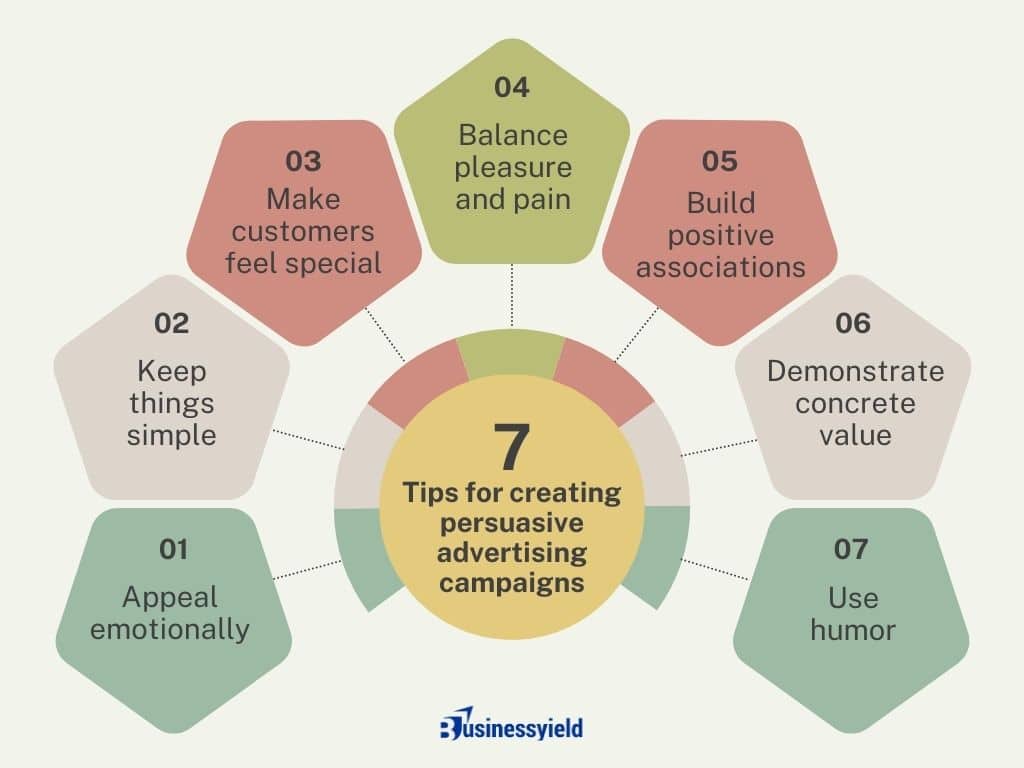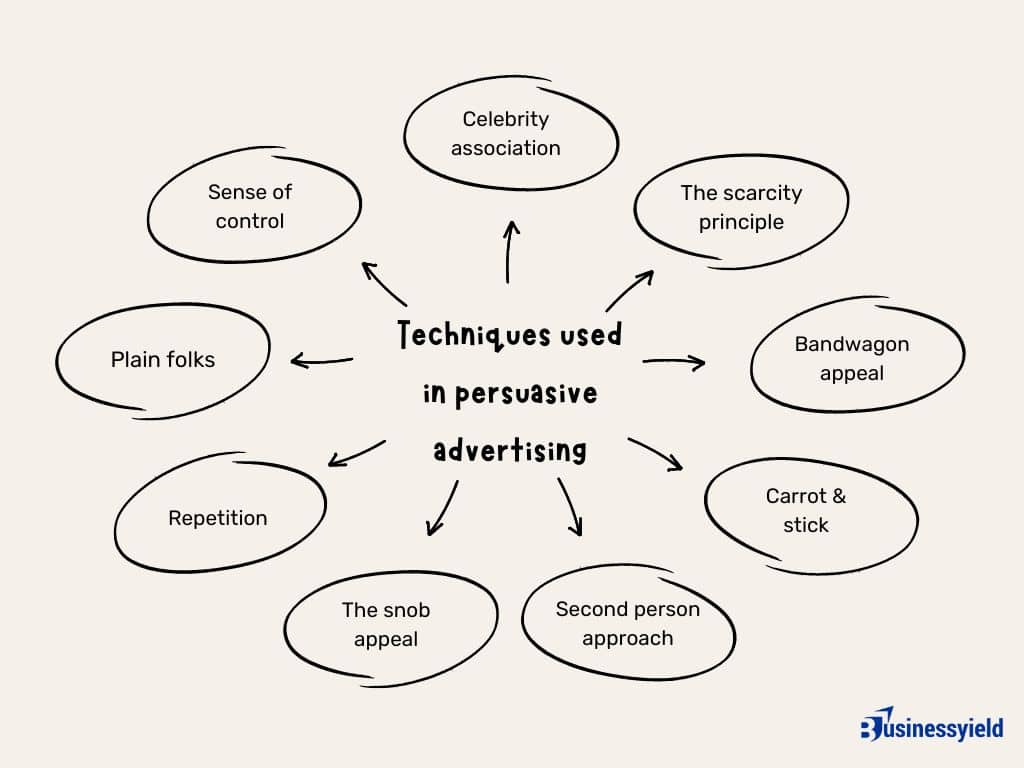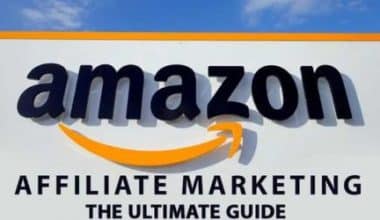Persuasive advertising does just what it sounds like – it persuades your customers. It appeals to them on an emotional level. It can bring in new audiences while using the opinions, feelings, and desires of your customers to compel them to purchase from your brand.
The world of digital advertising is incredibly competitive, and this can make it hard for your products and services to stand out amongst the noise. Persuasive advertising can help you attract the interest of your key target audiences and convince them to give your product a try without being overly educational and informative.
Key Points
- Persuasive advertising attempts to convince a consumer to purchase a product or service by appealing to their needs and desires.
- It convinces people that they will be empowered enough to eventually make an informed purchase once they’re informed about your product.
- Persuasive advertising uses strategies belonging to three categories: ethos, pathos, and logos.
- Persuasive ads take finesse to craft. However, there are core principles you can keep in mind as you write your persuasive advertising.
- Informative advertising, on the other hand, involves companies using facts and figures to communicate the benefits of products.
Understanding the concept of persuasive advertising
Persuasive advertising is a method of advertising that attempts to convince a consumer to purchase a product or service by appealing to their needs and desires. It attempts to frame products in a positive light and convince consumers about their benefits and uses emotional responses instead of facts to motivate consumers.
Persuasive advertising strategies belong to three overall categories:
- Ethos: Appeals to ethics, character and credibility
- Logos: Appeals to reason and logic
- Pathos: Appeals to feelings and emotions
Persuasive advertising works by not just informing the consumer by making them feel smart. It convinces people that they will be empowered enough to eventually make an informed purchase once they’re informed about your product, brand, or service. Once you’ve established an advertising strategy with persuasive ads, you can:
- Build brand loyalty and customer advocacy
- Prove more value for your products or services
- Maintain credibility amongst consumers
- Establish a positive association with your brand
Persuasive advertising leverages the desires and interests of consumers to convince them to purchase a product or service. This form of advertising often focuses on the benefits the product or service can offer the end-user.
Persuasive advertising strategies
As mentioned above, persuasive advertising uses strategies belonging to three categories: ethos, pathos, and logos. These are the three types of emotions that are meant to persuade people.
Ethos
Ethos persuades consumers with credibility, authority, and trust. Advertisements that use ethos demonstrate that your company has a reputable presence in your industry. Consumers can only trust you and your products if credibility is the bedrock of your brand.
In advertising, one of the primary ways to build this trust is with either an authority figure or a celebrity testimonial. For example, if you sell skincare, you could create an advertisement where a celebrity (with flawless skin) endorses your products. Or, if your company sells basketball shoes, an ad with a famous basketball player could establish credibility.
In general, even just having ads with positive images of that celebrity or industry professional can persuade customers.
READ: How Brand Partnerships Can Improve Consumer Engagement and Business Growth
Pathos
Pathos uses emotional appeals the most by trying to elicit feelings like joy, nostalgia, sympathy, frustration, or surprise. Advertisements that use pathos allow you to connect with the consumer and persuade them to take action (engaging with your company or making a purchase) based on how they’re feeling.
Pathos ads rely on storytelling, connection, and humanity. If you want customers to donate to your animal nonprofit, showing an ad with a cute puppy can really pull at the heartstrings. Or, if you want customers to know your clothing business cares about climate change, you can create an ad with an influential message on how your company doesn’t use toxic fabrics, actively fights against fast fashion, and uses sustainable packaging.
SEE: Sustainable Packaging Solutions for Makeup Buyers: Exploring the Latest Trends
Logos
Logos appeals to the consumer’s sense of logic and intellect. Advertisements that use logos persuade consumers with data, facts, or statistics.
For example, if you work in the marketing department at a university and you want to make an advertisement that boosts football recruitment, you could include a statistic about how the school is #10 in defense in the country.
Tips for creating persuasive advertising campaigns
Persuasive ads take finesse to craft. However, there are core principles you can keep in mind as you write your own persuasive advertising:

1. Appeal emotionally
At the center of nearly all persuasive advertising is an emotional appeal. Think of ways your ads can create positive emotions in potential customers. Make people laugh. Tap into their innate desires for connection, control, and self-realization.
It’s unnecessary to completely forgo logic when creating persuasive ads. However, the emphasis should be on creating a positive emotional reaction to the ad and planting a seed of desire for your unique goods or services.
2. Keep things simple
Try to keep your ad copy short, sweet, and to the point in addition to being emotionally impactful. This type of advertising works best as a marketing strategy when you refrain from over-complicating things. Focus on a specific product and give one extremely compelling reason customers should desire it.
SEE: What Does an SEO Copywriter Do?
3. Make customers feel special
Use a variety of persuasive techniques to make potential customers feel special. Sometimes it’s necessary to do research ahead of time to accomplish this.
For example, ask members of your target audience which appeals to them more: being part of a group or being a unique trendsetter. This will help you determine whether your ads should make someone want to join the bandwagon (i.e. “Everybody’s buying our product”) or strike first (i.e. “Be one of our first customers to take advantage of this exclusive offer”).
4. Balance pleasure and pain
Decide on what desired action your ad should lead a customer to take, then show them why that action will lead to maximized pleasure and minimized pain.
For instance, think of an ad that starts slowly, showing five-star customer reviews, and then moves much faster while an upbeat and popular song plays in the background. This shows how happy your product makes people. At the end of the ad, you could mention there’s limited availability for this high-value product of yours.
SEE: Choosing Upselling & Cross-selling Strategies to Strengthen Your Sales Approach
This creates a sense of urgency via the scarcity principle, while also insinuating your potential customers will lose out unless they act fast.
5. Build positive associations
Tap into the ethos (or credibility) of popular, well-liked people by getting them to tout your brand. This can range from positive endorsements and testimonials from people in your local community to a nationally recognized celebrity spokesperson. Both small businesses and large corporations can benefit from reaching out to influencers like this to create a positive association between their own personal brands and your product or service.
6. Demonstrate concrete value
Even though you should place a premium on appealing to emotion, you still need to find some way to demonstrate the innate, tangible value of your product. Anchor any positive images or clips with a tie-in to what you are actually selling.
Also, be sure to include your contact information, such as a web address or phone number, so your potential customers can act immediately.
7. Use humor
Making people laugh is one of the most tried-and-true persuasive advertising techniques. It immediately creates a positive feeling about your product. As an example, imagine a ketchup brand that runs a print ad. In the advertisement, their own ketchup is at the finish line of a marathon while other competing brands of ketchup are far behind in the distance.
The copy might read something like “No matter how hard they try, they just can’t ketchup to us.”
Implementing persuasive advertising
Techniques used in persuasive advertising
Now that we’ve gone over what persuasive advertising is and the three fundamental emotions that are tied to it, let’s go over some more specific persuasive advertising techniques.

Celebrity association
As we’ve mentioned with ethos persuasive advertising, celebrity testimony is ideal for making your brand seem desirable or glamorous. Lots of people look up to celebrities or influencers. We tend to value their opinion and trust them simply because they’re famous.
If a celebrity says that they use your brand’s makeup, people are more likely to buy from your brand. If an influencer supports your company’s mission, people are likely to believe that you have an ethical mission.
This works in politics all the time too, with politicians endorsing other politicians or celebrities stating publicly who they’re voting for.
SEE: Best Guide to Implementing Differentiated Marketing Strategies for Brand Differentiation
The scarcity principle
The scarcity principle makes it seem like your product or service has increased value from limited availability. For example, some marketers will use a countdown clock on an online shopping bag page or send push notifications that customers only have so much time to take advantage of an exclusive offer.
The scarcity principle ultimately elicits a sense of urgency to the customer. It persuades them that they need to buy from you now before it’s all gone.
Bandwagon appeal
The bandwagon appeal relies mostly on social pressure or the belief that “everyone else is doing it.” When a company appeals to popular trends, customers will start to feel like they may be missing out if they don’t purchase from your brand. An example of the bandwagon appeal could be promoting a restaurant as having healthy or organic options because of the common belief that eating healthier is better for you.
Avant-garde
The avant-garde technique appeals to a consumer’s desire to be the first one to have a product. This type of advertisement suggests the user is an early adaptor and on the forefront of technology. These messages may appeal to people who want to be unique and have what others don’t.
The carrot and the stick
This phrase originated as a metaphor for combining reward and punishment. The carrot and the stick technique is similar to the bandwagon appeal, but instead, it implies that a customer will gain something if they use your product or service but lose something if they don’t.
For example, a company that sells cybersecurity software could persuade a customer by promising improved security and protection from hackers. Simultaneously, this ad would imply that if you don’t purchase that software, you will become vulnerable to cyberattacks.
SEE: CYBERSECURITY FRAMEWORKS: How to Choose the Right Cybersecurity Frameworks for Your SMBs
Second person approach
This advertising approach can be applied to a variety of persuasive ad types. Using second-person pronouns—you, your, and yours—helps you connect to your audience on a personal level. It projects your idea of their persona back onto them to help them visualize how they should engage with your brand.
One message per advertisement
To immediately hook people and persuade them to read or watch the rest of your advertisement, try sticking to only one message. Spotlighting your product or offer’s main benefit or feature will make it easy for your customers to understand its value.
It will also increase the likelihood of their conversion because you’re only conveying one message to your audience: your product’s main feature will benefit your customer’s life somehow.
The snob appeal
Instead of making the customer feel like they can be like everyone else — as seen with the bandwagon appeal — the snob appeal makes the customer feel like they can be superior to everyone else. This type of persuasive advertising speaks to the customer’s uniqueness, implying that they could become part of an elite group of people with good taste or high status.
Many brands that use this advertising tactic legitimately sell lavish, high-end products, like luxury cars, clothes, or jewelry. However, most companies don’t need to sell luxury products to use the snob appeal tactic.
Some examples could be a baby food commercial implying that the viewer will be a great, attentive parent if they use their product, or a perfume brand implying that their product will make the customer smell better than anyone else in the room.
READ: What Is Behavioral Segmentation in Marketing? Types, Examples & Variables
Repetition
Repetition drives a message home, so the more consumers are exposed to a certain message, the more likely they are to take action. This can be within an ad itself, or over a series of ads all putting across the same message.
Plain folks
Plain folks is a persuasion technique that has been around for decades by using regular, “plain” people to promote something. This tactic reverses the snob appeal by saying “We’re just like you” instead of saying “You’ll be just like us.” Ads that use plain folks show everyday people using regular products or services, implying that the brand is reliable, common, and relatable.
Sometimes, celebrities and influencers use this tactic to demonstrate that they’re regular people just like you who need groceries, cleaning supplies, a reliable insurance company, or—in the case of our ethos example—a takeout meal.
Sense of control
As much as advertising is used to persuade people to buy things, no one likes to feel pushed into a corner, and everyone likes to feel in control. Ads that give people a sense of control, by e.g. giving a variety of options to choose from, or making it clear that the choice to buy is up to the customer, are likely to attract people.
Advantages and disadvantages of persuasive advertising
Persuasive advertising, like any other type of advertising, has both benefits and drawbacks. Let’s now consider all of them to understand how it works and realize the pros a company can obtain.
First and foremost, this strategy sticks to a customer-centric approach, meaning that a company focuses on making customers satisfied and tries to meet their individual needs. Secondly, the strategy is always based on arguments supporting a product’s value and persuading customers that it can solve their problems. It helps convince consumers to purchase a certain product based on its quality, value, features, or benefits.
As a result, businesses succeed in establishing credibility and trust in their products.
READ: Building Trust Through Quality: Small Business Edition
Persuasive advertising influences buyers through emotions, needs, and desires. Customers choose specific brands because of the way they feel about their products. The right approach and the reasons for people to purchase a particular product create a connection between a customer and a brand and establish a strong relationship between them, which results in brand loyalty.
However, this type of advertising also has several disadvantages:
- the impersonal character of advertising;
- dissatisfied consumers;
- sometimes a deceptive picture of products;
- customer churn.
Examples of persuasive ads
Let’s go over some ethos, pathos, and logos persuasive advertising examples that you may recognize.
Ethos: Uber Eats
In 2021, Uber Eats launched its “Tonight I’ll be Eating” commercial, starring Sir Elton John and Lil Nas X, two celebrities young and old music fans are sure to recognize. Known for their lavish clothes and stage presences, the artists both describe what they’ll be eating from Uber Eats while dressed in the other person’s apparel.
In one ad, Sir Elton wears one of Lil Nas’ bedazzled, pink cowboy costumes from his debut “Old Town Road” phase, while Lil Nas wears Sir Elton’s vividly feathered costume from the “Rocketman” film.
Now, neither of these artistes is known for their culinary talents, so they may not be the best fit. However, these compelling ads are still excellent instances of ethos. The mere appearance of two musicians dressed in dramatic, bright costumes is enough to make customers think positively of Uber Eats.
SEE: Understanding Market Penetration Strategies and How to Use It to Increase Sales
Pathos: Burger king
In anticipation of Mother’s Day in 2022, Burger King Germany launched their “Pregnancy Whopper” marketing. The campaign began with a poll of expectant moms on their unusual pregnancy desires. Then, for one day at a single location, the fast food company sold a variety of Pregnancy Whoppers, including pickles and whipped cream, sunny-side-up eggs and bananas, and even fried fish, curries, and bratwurst.
Their ads showed expecting mothers diving into each Whopper with a sense of excitement while the women’s male partners exhibited confusion.
What marks this ad as one of the finest instances of pathos is the wide range of emotions it evoked from people worldwide. For several people, especially pregnant women, seeing the Pregnancy Whoppers evoked pleasant emotions like excitement, happiness, and fulfillment.
However, the campaign also prompted negative emotions from non-pregnant customers, like disgust, bewilderment, and shock. It ultimately received so much social media and internet attention that Burger King quickly became infamous for its ability to spark both delight and disgust among consumers.
Logos: ShamWow
In 2006, the ShamWow infomercial was on nearly everyone’s TV screen in the United States. The television advertisement features a fast-talking, energetic salesman who dives straight into the usefulness and value of the ShamWow towel within the first five seconds of the ad.
The host describes the ShamWow as a highly absorbent, washable towel and then immediately shows live demonstrations by wiping surfaces and wringing out excess liquid. As he makes statistical declarations—such as the towel soaking “up to twenty times its weight in liquid” and that it “lasts ten years”—the host shows more footage to back up his claims.
The original ShamWow commercial is a major example of logos. The host not only tells the viewer about the product’s value and benefits, but he is quick to demonstrate them in real-time too.
By letting the audience see the ShamWow’s results and effectiveness, the ad makes it seem like the viewer is being given plenty of real-world, factual information to be persuaded.
Additional examples include:
Apple
Apple, a global technological brand, appealed to reason and logic to entice its audience to purchase what was, at the time, the newest iPhone.
Instead of comparing the smartphone to competitors, Apple focused on what its product had to offer in the way of technological and physical advancements. These include Face ID software and durable glass, two features its audience finds valuable.
SEE: APPLE BRAND AND LOYALTY: Creating a Brand the Apples Way
Heinz
Heinz, the condiment brand, used persuasive advertising in their partnership with singer Ed Sheeran to appeal to UK audiences. Ed Sheeran, a notable fan of Heinz, appeared in an ad where he added the product to many different types of food and fancy and luxurious restaurants.
This ad helped to build a positive association between the singer and the product while making it feel approachable and enticing.
Lyft
Lyft, the ride-sharing company, used persuasive advertising in their advertisements where they thanked people who were achievers, hard workers, and also drivers.
By focusing on the customers who needed the product rather than the ride-share app itself, Lyft was able to make an emotional connection between people who strive to achieve their goals and the brand itself.
HP
HP, a global technological device company, targeted a specific audience with its “Nobody’s Watching” campaign. The persuasive ads campaign centers around the ability of users to easily turn off the camera on their laptops, allowing them to do what they wish without worrying about being viewed by others.
By identifying and gearing the persuasive advertising messaging to a specific audience’s concern about their product, HP was able to show why this really is not an issue at all.
Essentially, the message was that you can be yourself while using your HP laptop.
Clorox
Clorox, the cleaning supply brand, used persuasive advertising with its “Trusted by Moms” campaign. The campaign used language that focused on how mothers are trusted cleaners and used that as an emotional hook to connect with audiences.
By avoiding specifics on how many moms bought their products, they were able to build a connection with mothers as a whole.
Persuasive advertising vs. informative advertising
Although both types help companies communicate the strength of their products and services, they are used in different situations and represent different strategies.
Persuasive advertising is a type of advertising that implies convincing customers and making them believe that a product or service is worth buying. With these types of ads, marketers appeal to emotions. Since facts and figures aren’t always enough to persuade a specific target audience, many brands try to establish emotional connections, which helps encourage consumers to purchase.
Informative advertising, on the other hand, involves companies using facts and figures to communicate the benefits of products to their target audience. Brands share truthful information about their products or services to highlight their value, benefits and features with a minimal appeal to customers’ emotions.
After obtaining accurate information about a certain good, a customer decides whether to buy it or not.
Simply put, the main difference is that persuasive advertising relies on emotions, whereas informative advertising is based on truthful facts and statistics.
Persuasive advertising: In conclusion
Advertising requires developing specific messages for targeted groups. Different audiences respond to different types of messages, and it’s important to create advertisements that motivate your consumers to take action. This is why grabbing the attention of your audiences and showing them the benefits of your product is important for building a strong online presence.
It’s important to understand what your audience values and what appeals to them. When done right, persuasive advertising can go a long way toward helping your brand build more loyalty and appeal to more people.
PERSUASIVE ADVERTISING: What It Is & How to Do It
Hot new business ideas 2023 with 100% success rate. Find 10 of them here (+ all you need)
WHAT IS A COPYWRITER: Job Description, How to Become One, Salary & Qualification
What Is the Purpose of an Essay? Understanding an Essay’s Goal






